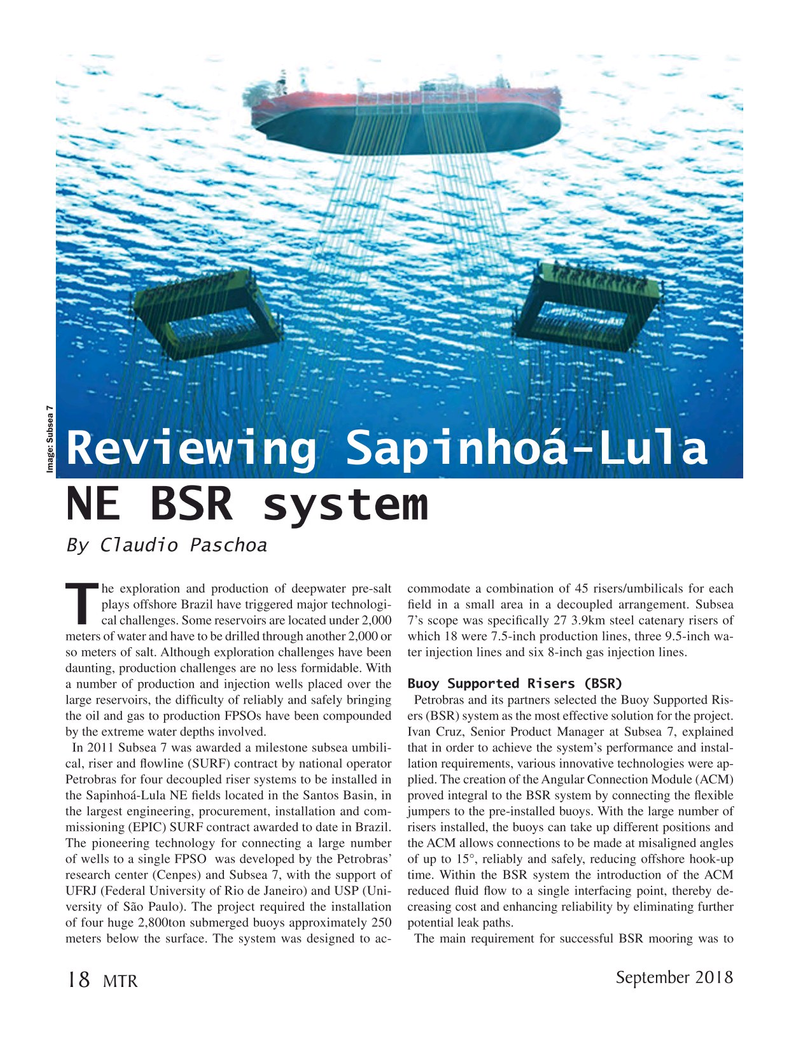
Page 18: of Marine Technology Magazine (September 2018)
Autonomous Vehicle Operations
Read this page in Pdf, Flash or Html5 edition of September 2018 Marine Technology Magazine
Reviewing Sapinhoá-Lula
Image: Subsea 7
NE BSR system
By Claudio Paschoa he exploration and production of deepwater pre-salt commodate a combination of 45 risers/umbilicals for each plays offshore Brazil have triggered major technologi- ? eld in a small area in a decoupled arrangement. Subsea
T cal challenges. Some reservoirs are located under 2,000 7’s scope was speci? cally 27 3.9km steel catenary risers of meters of water and have to be drilled through another 2,000 or which 18 were 7.5-inch production lines, three 9.5-inch wa- so meters of salt. Although exploration challenges have been ter injection lines and six 8-inch gas injection lines.
daunting, production challenges are no less formidable. With a number of production and injection wells placed over the Buoy Supported Risers (BSR) large reservoirs, the dif? culty of reliably and safely bringing Petrobras and its partners selected the Buoy Supported Ris- the oil and gas to production FPSOs have been compounded ers (BSR) system as the most effective solution for the project. by the extreme water depths involved. Ivan Cruz, Senior Product Manager at Subsea 7, explained
In 2011 Subsea 7 was awarded a milestone subsea umbili- that in order to achieve the system’s performance and instal- cal, riser and ? owline (SURF) contract by national operator lation requirements, various innovative technologies were ap-
Petrobras for four decoupled riser systems to be installed in plied. The creation of the Angular Connection Module (ACM) the Sapinhoá-Lula NE ? elds located in the Santos Basin, in proved integral to the BSR system by connecting the ? exible the largest engineering, procurement, installation and com- jumpers to the pre-installed buoys. With the large number of missioning (EPIC) SURF contract awarded to date in Brazil. risers installed, the buoys can take up different positions and
The pioneering technology for connecting a large number the ACM allows connections to be made at misaligned angles of wells to a single FPSO was developed by the Petrobras’ of up to 15°, reliably and safely, reducing offshore hook-up research center (Cenpes) and Subsea 7, with the support of time. Within the BSR system the introduction of the ACM
UFRJ (Federal University of Rio de Janeiro) and USP (Uni- reduced ? uid ? ow to a single interfacing point, thereby de- versity of São Paulo). The project required the installation creasing cost and enhancing reliability by eliminating further of four huge 2,800ton submerged buoys approximately 250 potential leak paths.
meters below the surface. The system was designed to ac- The main requirement for successful BSR mooring was to
September 2018
MTR 18
MTR #7 (18-33).indd 18 MTR #7 (18-33).indd 18 9/6/2018 10:39:42 AM9/6/2018 10:39:42 AM

 17
17

 19
19
